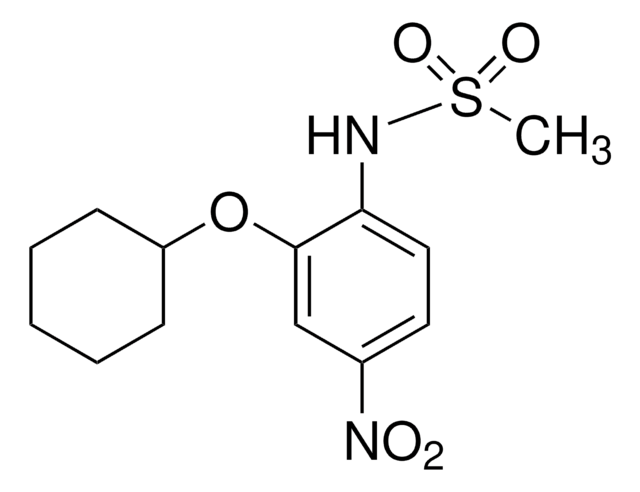推荐产品
方案
≥98% (HPLC)
表单
powder
颜色
white to brown
溶解性
DMSO: 2 mg/mL, clear
储存温度
2-8°C
SMILES字符串
O=C(N(C1=CC=C(Cl)C=C1)C)C(N=C2)=CN3C2=NC=C3C4=CC=C(C(NC)=O)C=C4
InChI
1S/C22H18ClN5O2/c1-24-21(29)15-5-3-14(4-6-15)19-11-26-20-12-25-18(13-28(19)20)22(30)27(2)17-9-7-16(23)8-10-17/h3-13H,1-2H3,(H,24,29)
InChI key
TYMFFISSODJRDV-UHFFFAOYSA-N
生化/生理作用
KDU691 is an orally active imidazopyrazine class antiparasitic that inhibits Plasmodium & Cryptosporidium phosphatidylinositol-4-OH kinase, PI(4)K, in an ATP-competitive, highly potent and selective manner (IC50/[ATP] = 1.5 nM/10 μM/P. vivax & 17 nM/3 μM/C. parvum PI(4)K) with little or no activity against human PI3Kα/β/γ/δ, PI4KIIIβ, VPS34, and 36 human protein kinases. KDU691 is effective against human pathogens P. falciparum, P. vivax, C. parvum and C. hominis, as well as simian parasite P. cynomolgi. KDU691 blocks Plasmodium development in all life-cycle stages and displays in vivo efficacy in murine models of malaria and cryptosporidiosis.
Orally active antiparasitic (antimalarial & anti-cryptosporidial), Plasmodium & Cryptosporidium phosphatidylinositol-4-OH kinase, PI(4)K, inhibitor.
储存分类代码
11 - Combustible Solids
WGK
WGK 3
闪点(°F)
Not applicable
闪点(°C)
Not applicable
Michelle Yi-Xiu Lim et al.
Nature microbiology, 16166-16166 (2016-09-20)
A molecular understanding of drug resistance mechanisms enables surveillance of the effectiveness of new antimicrobial therapies during development and deployment in the field. We used conventional drug resistance selection as well as a regime of limiting dilution at early stages
Pamela Orjuela-Sanchez et al.
ACS infectious diseases, 4(4), 531-540 (2018-03-16)
To develop new drugs and vaccines for malaria elimination, it will be necessary to discover biological interventions, including small molecules that act against Plasmodium vivax exoerythrocytic forms. However, a robust in vitro culture system for P. vivax is still lacking. Thus
L Dembele et al.
Scientific reports, 7(1), 2325-2325 (2017-05-26)
Malaria control and elimination are threatened by the emergence and spread of resistance to artemisinin-based combination therapies (ACTs). Experimental evidence suggests that when an artemisinin (ART)-sensitive (K13 wild-type) Plasmodium falciparum strain is exposed to ART derivatives such as dihydroartemisinin (DHA)
Case W McNamara et al.
Nature, 504(7479), 248-253 (2013-11-29)
Achieving the goal of malaria elimination will depend on targeting Plasmodium pathways essential across all life stages. Here we identify a lipid kinase, phosphatidylinositol-4-OH kinase (PI(4)K), as the target of imidazopyrazines, a new antimalarial compound class that inhibits the intracellular
Nil Gural et al.
Cell host & microbe, 23(3), 395-406 (2018-02-27)
The unique relapsing nature of Plasmodium vivax infection is a major barrier to malaria eradication. Upon infection, dormant liver-stage forms, hypnozoites, linger for weeks to months and then relapse to cause recurrent blood-stage infection. Very little is known about hypnozoite
我们的科学家团队拥有各种研究领域经验,包括生命科学、材料科学、化学合成、色谱、分析及许多其他领域.
联系技术服务部门






